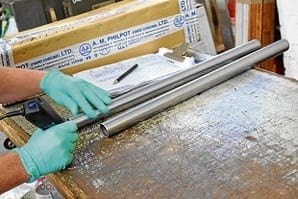
First indication that things are not well in the suspension department is that the front end starts bouncing around and there’s a tell-tale trickle of oil dribbling down the fork leg. Okay, so it might just be the seal has gone past its sell-by date and dropping the slider off, replacing it and refilling with oil means all will be well. If it’s not then it’s probable there’s some damage to the fork stanchions or maybe they’re just worn past their tolerance level.
Damage is easy to spot and it’s generally in the form of pitting that rips the seals to shreds, whereas wear will need measuring. Either way there are two options, buy new ones or have it repaired. If the first option is possible then stop reading, if not then carry on into the world of hard chrome plating with OBM.
First of all…
Don’t mix up hard chrome with ordinary chrome. The former is an engineering process that happens to look nice, while the latter’s prime function is to make things bright and shiny. Though for us motorcyclists and for the purpose of this short feature, fork stanchions are what we’re talking about, there are other bits that can benefit from the process, things such as damper rods or the ends of shafts.
 In all cases the process is relatively simple to describe though needs some serious chemicals and equipment to do. Basically… and this is very basically… any wear is ground out of the part, it is then plated to oversize, then ground back to the original dimension.
In all cases the process is relatively simple to describe though needs some serious chemicals and equipment to do. Basically… and this is very basically… any wear is ground out of the part, it is then plated to oversize, then ground back to the original dimension.
With a set of stanchions pitted and in no shape to put on the bike we’re rebuilding we had a word with OBM advertiser AM Philpot in Luton and the guys were happy for us to come along and photograph the hard chroming process.
With top man Andy having to dash off, OBM was looked after by Steve Holland who explained the way Philpot’s team works and what happens to your stanchions when they arrive.
First of all is the tech inspection, where the stanchions are marked in order to keep pairs together and then they’re logged on a job sheet that follows the work right through from start to finish. Steve points out here that the stanchions will be bent and have to be straightened in the press.
After that they’re ground true on a centreless grinder if they’re straight stanchions and a centre grinder if there is a bush recess that needs to be kept concentric to the stanchion. Ours were straight so centreless was fine. This process grinds off the old chrome if there was any on and removes the damage to the surface. It is worth mentioning that the bit that is most important is where the seal rubs and this is the prime consideration for the Philpot team’s attention. “While generally speaking the whole tube is ground perfect, in some cases it’s not possible. As long as the seal area is perfect the rest is less important,” says Steve.
So, what’s next? Polishing before plating which removes any blemishes, a quick rinse then masking and robbers are applied. Whoa! Robbers? Yes, robbers. “Chrome isn’t deposited evenly so sticking robbers in either end of a tube will help the spread of chrome,” Steve grins.
Next up is the earthing rod to complete a circuit and allow the chrome to be applied, then the fork tubes spend a couple of nights in the plating baths. Typically around 20thou of chrome is applied, which is plenty enough for final grinding and polishing. That done the forks are rinsed, dried and packed off to the customer. “I would advise that as soon as your forks are returned give them a good wash off to get rid of any grit or dirt, we do or best but just in case,” says Steve. ![]()





